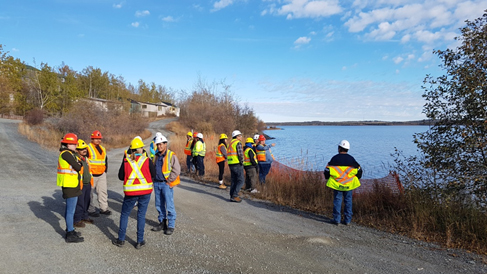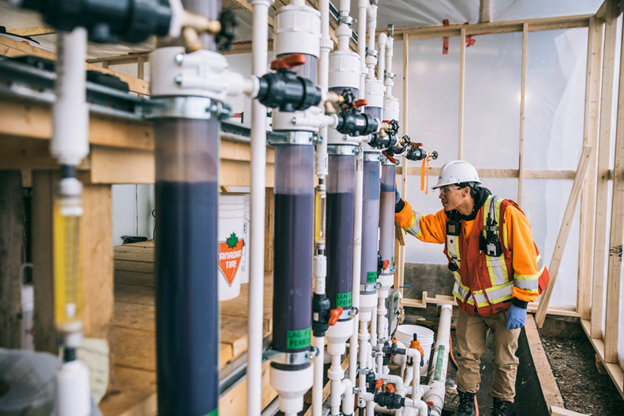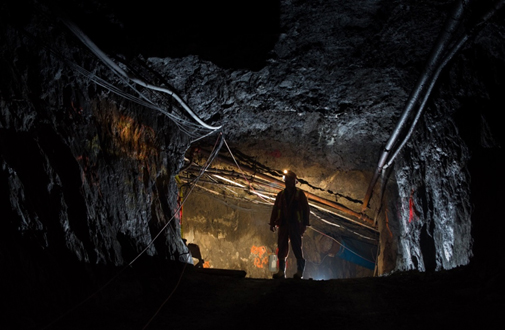Giant Mine newsletter: September 2018
Get the most recent updates on the Giant Mine remediation project.
On this page
Engagement activity update
Yellowknives Dene First Nation site tour

The Giant Mine Remediation Project team recognizes the importance of engaging key partners in the remediation of the site. As part of ongoing engagement efforts, 20 members of the Yellowknives Dene First Nation toured the Giant Mine site on September 24, 2018. They were able to see the care and maintenance work that is ongoing at the site, as well as learn how the project team plans to address different aspects of the site in the Closure and Reclamation Plan.
Quantitative risk assessment
In early September, the project team held a risk identification session with the Yellowknives Dene First Nation. This took place over two days in Dettah. Next, the project team will screen the risk scenarios collected at all of the risk identification sessions from members of the Working Group and key Yellowknives Dene First Nation participants. This will help to narrow the list to medium to high risks that will be analyzed more closely. The project team will work with key partners and stakeholders to rank the risks. Once the screening is complete, the Project team will share the results of the analysis more broadly. The project team anticipates this will occur in November at the earliest.
Stress study
The project team is getting ready to kick off its stress study. This study was recommended in measure 10 of the Report of Environmental Assessment. Dr. Ketan Shankardass from Wilfrid Laurier University, who will be conducting the study, met with the Giant Mine Working Group in August and the Giant Mine Advisory Committee in September to discuss the study. He will be using their input to develop and finalize the survey that will be used to measure stress related to the Giant Mine. Dr. Shankardass will be in the Yellowknife area to work with affected parties to further refine the survey component of the study from October 15-19, 2018.
Draft water licence package
The Giant Mine Remediation Project team is working toward applying for its water licence in January 2019. As committed to in the overview given at a public meeting in June, the project team held three days of technical workshops with affected parties. These workshops focused on the technical aspects of the water licence submission, including the Closure and Reclamation Plan, and were planned and developed based on feedback from stakeholders. Input from these sessions will help the team make adjustments to the water licence package before submitting it to the Mackenzie Valley Land and Water Board.
Science YouTube personality features the Giant Mine

In June, YouTube personality Tom Scott, visited the Giant Mine site. As the host of a science-focused web channel, he wanted to learn and share with his worldwide audience how the project team plans to freeze the arsenic trioxide dust in place. The video he produced can be found on YouTube.
The pilot plant is up and running

The pilot Water Treatment Plant has been built and is now operating. This pilot plant will determine if using adsorbents to remove arsenic is viable to treat water at the site. It will support the design of the new Water Treatment Plant required for remediation. The new plant will need to be able to treat the minewater to meet the project's treatment goals for arsenic. It will also treat to other criteria protective of the environment and human health that the Mackenzie Valley Land and Water Board will set as part of the coming regulatory process related to the water licence application. The pilot plant began operating in August. It will operate into the Fall.
Update on the socio-economic approach to site remediation
The Giant Mine Remediation Project strives to deliver social and economic benefits to Indigenous and Northern communities while protecting the environment and people's health. Parsons Inc., the main construction manager, uses a number of tools to help the project team achieve their goal to foster employment, training, and apprenticeships for Indigenous workers, and encourage subcontracting to Indigenous and Northern businesses.
You can learn more about the project's commitment to the North on our Socio-Economic approach webpage.
Those interested in upcoming contract opportunities can visit the Merx website, where Parsons posts all opportunities for potential bidders and other interested parties. Parsons also maintains a website specific to the work for the Giant Mine Remediation Project.
Contract award update

As the main construction manager and prime contractor at Giant Mine, Parsons Inc., has many responsibilities including overall site safety, scheduling, and subcontracting to Indigenous or northern firms where practicable. Results of its recent tenders include the following entities working on the Giant Mine Remediation Project:
Underground care and maintenance
Parsons Inc. subcontracted Procon/Det'on Cho Joint Venture to conduct the care and maintenance work required to keep the underground in a stable condition until remediation can move forward. This contract was valued at $12,560,396.00. As part of its successful bid, Procon/Det'on Cho committed to 1920 hours of training, that 33% of the labour required will be conducted by Indigenous staff, and that 98% of the subcontracting dollar value will be to Indigenous companies.
Laboratory testing services (for the Effluent Treatment Plant (ETP) and pilot plant)
Parsons Inc. subcontracted Yellowknife-based, territorial Taiga Environmental Laboratory to provide testing services for water samples for the ETP and pilot plant. This contract was valued at $154,988.00. As part of its successful bid, the Taiga lab committed to 60 hours of training, that 11.1% of the labour required will be conducted by Indigenous staff, and that 2.5% of the subcontracting dollar value will be to Indigenous companies.
C-Shaft Power Feeders Installation
Parsons Inc. subcontracted Denesoline Ryfan Limited to install power feeders to the C-Shaft area. This contract was valued at $377,985.00. As part of its successful bid, Denesoline Ryfan committed that 100% subcontracting dollar value will be to Northern Indigenous companies.
Akaitcho pump installation
Parsons Inc. subcontracted to Yellowknife's Nahanni Construction Limited to install power feeders to the C-shaft area. This contract was valued at $1,642,418.85.
Contacting the main construction manager team
Parsons Inc., the main construction manager, now has a webpage specific to the work of the Giant Mine Remediation Project. You can visit their site for updates on the project as well as employment and contracting opportunities. For more information you can contact their economic development staff.
Economic development manager
Louie Azzolini
Louie.azzolini@parsons.ca
(867)688-0655
Community liaison officer
Lisa Colas
Lisa.colas@parsons.ca
Visit Parsons MCM website for more ways to get in touch.
Update on the backfilling of stope complex C5-09
The backfilling of stope complex C5-09 is ongoing. Work is on track to finish in November. To date, more than 23,000 cubic metres of backfill material has been delivered. The backfill material consists mainly of paste made from a mixture of tailings, water and binder (cement and slag) and inert rock material. There is also a section of backfill that is a self-leveling concrete. This is to increase strength and stability in the central core of the stope complex.
The C5-09 complex is very large in size. It stretches the length of several blocks and is several stories deep in height. This requires a significant amount of material to fill in order to ensure it remains stable. Once complete, the project team does not anticipate that any other voids in the underground will need to be filled before the remediation begins.

